SECTION I
TIME: 60 MINUTES
80 MULTIPLE-CHOICE QUESTIONS
DIRECTIONS: Answer the multiple-choice questions below. Some are based on images. In this book the illustrations are at the top of each set of questions. Select the multiple-choice response that best completes each statement or question. You will have 60 minutes to answer the multiple-choice questions.
Questions 1–4 are based on Figure 1.
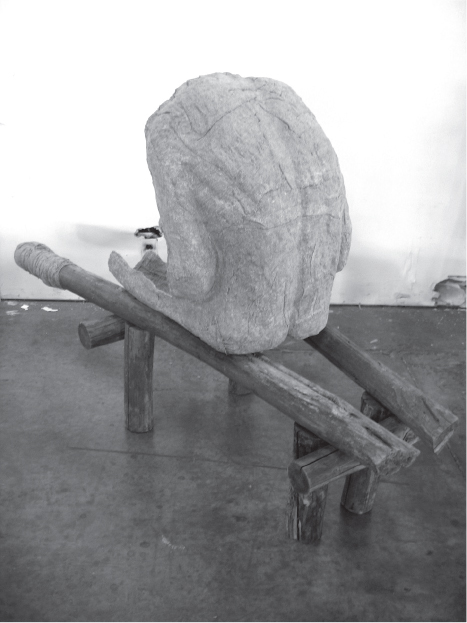
Figure 1
1.Works like Magdalene Abakanowicz’s Androgyne III symbolize the
(A)emptiness of modern life
(B)return to the classical figure
(C)advance of modern technology and its effect on the human condition
(D)effects of pollution and global warming
2.The artist uses burlap as a material in part because it
(A)is transparent and encourages us to see through the figures
(B)is costly and represents elite power
(C)imitates the appearance of human skin
(D)is durable and needs no further care
3.The work is placed in the center of the room so that
(A)other figures can be placed around it and interact with it
(B)a contrast between solids and voids can be appreciated
(C)people can be encouraged to touch the work and experience it first hand
(D)it will block people from passing through the room and force them to consider it
4.This abstracted human form with contrasting solids and voids is compositionally similar to
(A)Augustus of Prima Porta
(B)Ikenga (shrine figure)
(C)Nio guardian figure
(D)Portrait of Sin Sukju

5.The choice of marble for the sculpture of George Washington by Jean-Antoine Houdon
(A)indicates the discovery of a cheap source of marble in Vermont
(B)symbolizes George Washington’s home in Mount Vernon, Virginia
(C)makes a parallel connection between Washington and great classical figures, who were also sculpted in marble
(D)makes the comparison of George Washington to marble sculptures of great rulers and pharaohs of ancient Egypt
Questions 6–9 are based on Figures 2 and 3.

Figure 2
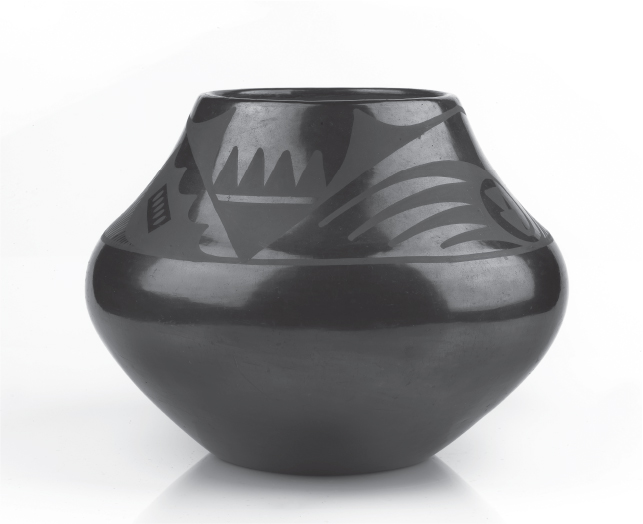
Figure 3
6.The objects on the left, called the David Vases, were made for
(A)export to Europe because Asian art was greatly prized
(B)Sir Percival David, a collector of Chinese ceramics
(C)practical use in a Chinese home
(D)an altar in a Chinese Daoist temple
7.Sources for the designs of works on the left are most likely from
(A)Chinese bronzes
(B)Japanese wood-block prints
(C)Indian Buddhist sculpture
(D)contact with Europeans
8.The work on the right represents a
(A)revival of interest in pottery making in a culture that had seen a decline in that art
(B)change to a more practical type of pottery rather than just aesthetically pleasing work
(C)change from a tourist driven pottery market to a practical use market
(D)move to reestablish pottery in European markets after a serious decline in quality
9.The work on the right can be compared with the works on the left in that both
(A)are done by unidentified artists
(B)use a combination of polished and matte surfaces
(C)are dominated by zigzag and geometric motifs
(D)were used in rituals

10.The Mexican flag today has an eagle perched on a cactus that rests on a rock. This symbol of Mexico can be found on which of the following works?
(A)Screen with the Siege of Belgrade and hunting scene
(B)Miguel González, Virgin of Guadalupe
(C)Miguel Cabrera, Sor Juana Inés de la Cruz
(D)lintel 25, structure 23, from Yaxchilán
11.The hypostyle halls common in Egyptian architecture—for example, the Temple of Amun-Re—can be said to have inspired later buildings, such as
(A)the Altar of Zeus and Athena, Pergamon
(B)the Mosque at Córdoba, Spain
(C)the Pazzi Chapel by Brunelleschi
(D)the Market of Trajan
12.Monticello reflects Thomas Jefferson’s wish to reference the
(A)spirituality of the Middle Ages in a modern context
(B)history of ancient Greece in a modern context
(C)ideals of the Roman Republic in a new country
(D)latest building techniques in France and England in the New World
13.Compared with the Florentine Renaissance, the Venetian Renaissance painted religious or historical works
(A)with a more human, worldly, and earthly quality
(B)as a grand heroic series of accomplishments
(C)with more geometric and mathematical precision
(D)as if taking place in their original settings with authentic archeological costumes and architectural structures
14.Unlike most Baroque architects, Francesco Borromini
(A)preferred to work in shades of white rather than in many colors
(B)built palaces and avoided working for the Catholic Church
(C)used landscaping to enhance the view of his buildings
(D)used glass as a reflective element in his designs
Questions 15–18 are based on Figures 4 and 5.
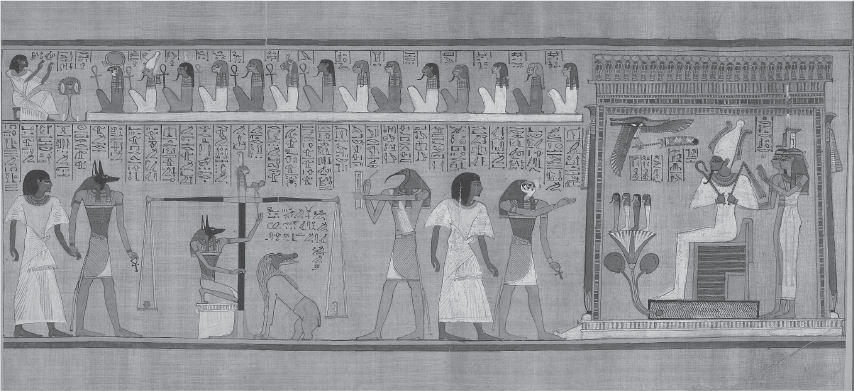
Figure 4

Figure 5
15.Both of these works incorporate narrative, but the narrative is different in that
(A)one tells the stories of the gods and their punishment of humans, and the other tells of the gods and how they help humans achieve enlightenment
(B)one is in hieroglyphics and the other is in Arabic
(C)one is read from right to left and the other from left to right
(D)one has an uncertain ending and the other has a predetermined ending
16.The work on the top was meant to explain
(A)vengeance upon a sinful man
(B)an innocent person’s journey to salvation and enlightenment
(C)coming of age in a tumultuous era
(D)the weighing of souls in the afterlife
17.The work on the bottom illustrates
(A)an historical episode seen from the victor’s point-of-view
(B)a mythical event that sheds light on contemporary society
(C)an allegory of war and violence
(D)a personal challenge in the face of overwhelming odds
18.The work on the bottom was meant to be
(A)on permanent display in a palace
(B)put away and taken out occasionally to be viewed by interested parties
(C)housed in a religious shrine as a moral lesson
(D)periodically studied and examined in a library

19.Mende masks were the only African masks worn by women. They were worn during ceremonies that
(A)prominently featured male participants
(B)honored female ancestors
(C)prepared girls for adulthood
(D)commemorated African queens
20.Shiva as Lord of Dance shows the god as a divine judge devastating the world. The same sentiments are expressed in which of the following works?
(A)Salcedo, Shibboleth
(B)Last Judgment, Sainte-Foy, Conques
(C)Giotto, Lamentation
(D)Churning of the Ocean of Milk
Questions 21–24 are based on Figures 6 and 7.

Figure 6
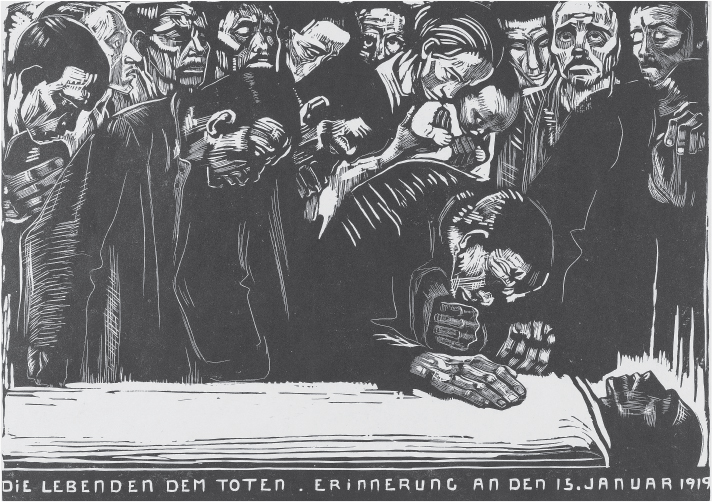
Figure 7
21.The print on the left was conceived as
(A)an illustration of the effects of the Thirty Years’ War
(B)an indictment of Catholicism and a promotion of Protestantism
(C)propaganda against the Counter-Reformation agents in Europe
(D)an affirmation of the Old Testament over the New Testament
22.These works are prints which
(A)were attached to early forms of newspapers and used as illustrations
(B)were used as ways to educate children in schools
(C)were deemed a higher art form than more traditional paintings
(D)could make multiple original copies and be distributed more widely
23.These prints were done in a format called a woodcut, which has a style that can be characterized as
(A)achieving precise details
(B)using sfumato to shade figures
(C)using stiff and angular figures
(D)using the pointillist techniques
24.The work on the right was done in the memory of
(A)a king of France who fell in love with an Italian princess and tragically died
(B)a Catholic martyr who was misunderstood by native people and was killed
(C)the artist’s brother who died tragically in war
(D)a slain member of the Communist party who led a revolt in Germany

25.Many works of art throughout history are made of spolia, reused architectural and sculptural elements. Which one of the following buildings is composed partly of spolia?
(A)Santa Sabina
(B)The Parthenon
(C)The White Temple and its ziggurat
(D)Il Gesù
Questions 26–29 are based on Figures 8 and 9.
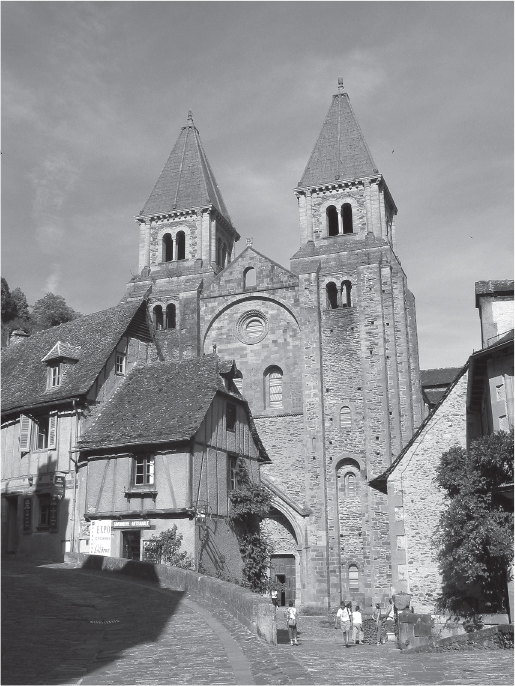
Figure 8

Figure 9
26.This church was built along pilgrimage roads headed to
(A)Jerusalem
(B)Rome
(C)Canterbury
(D)Santiago de Compostela
27.In order accommodate the number of pilgrims, the church has been designed with
(A)a large pair of bell towers
(B)sculpture on the façade
(C)an ambulatory around the altar
(D)an extensive crypt
28.As a pilgrimage center, it performs essentially the same role as
(A)the Palace of Versailles
(B)Forbidden City
(C)Great Stupa at Sanchi
(D)Basilica of Ulpia
29.As a pilgrimage center, this building houses reliquaries. A reliquary can be defined as
(A)an object that holds sacred objects
(B)a place where people were baptized into the Christian faith
(C)a series of carvings that tell the story of Jesus’s life
(D)a woven product that is designed on a loom

30.Vigée Le Brun’s Self-Portrait pays tribute to her favorite patron, Marie Antoinette, by
(A)including symbols of Marie Antoinette’s reign
(B)having the artist dressed as the queen
(C)having the queen look at Vigée Le Brun with admiration
(D)including a lengthy quotation from the queen
31.The conical tower at Great Zimbabwe is modeled on
(A)a lookout tower, which made enemies more visible
(B)a minaret, which calls people to prayer
(C)a bell tower, which was used to signal royal events
(D)a grain silo, which indicated that control over food symbolized wealth and power
32.Which one of the following works is an example of a caricature?
(A)Daumier, Nadar Raising Photography to the Height of Art
(B)Portrait of Sin Sukju
(C)Mutu, Preying Mantra
(D)Smith, Lying with the Wolf
33.Which of the following works has experienced a form of iconoclasm?
(A)Bamiyan Buddhas
(B)Merovingian looped fibulae
(C)Lukasa (memory board)
(D)Velázquez, Las Meninas
34.Which of the following contains an imperial portrait?
(A)White Temple and its ziggurat
(B)Taj Mahal
(C)San Vitale
(D)Machu Picchu
35.The bas-reliefs on the walls of the Palace at Persepolis depict
(A)Trajan’s conquering of the Dacians
(B)the battle between the gods and the giants
(C)Darius’s imperial guard, called the Immortals
(D)a listing of laws outlining a civil code
Questions 36–38 refer to Figure 10.
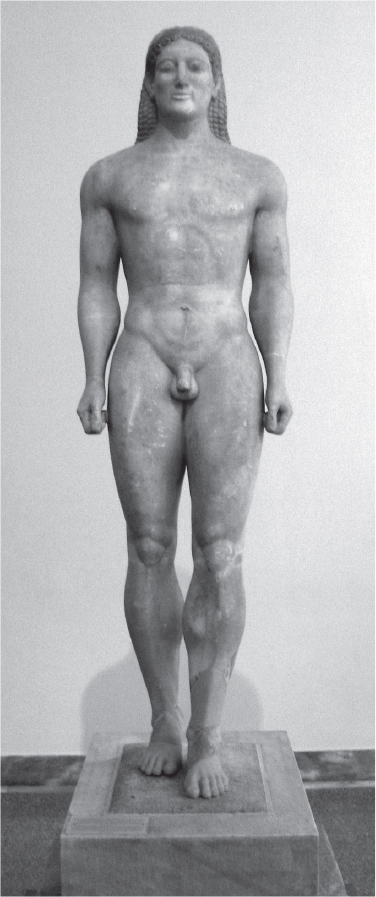
Figure 10
36.This statue is similar to other Greek kouroi in that it is inspired by
(A)Ancient Near Eastern figures
(B)Egyptian sculptures
(C)Roman emperors
(D)Polykleitos’s theories
37.This sculpture was different from female sculptures of the same date in that it
(A)was unpainted
(B)is disproportionate to the human body
(C)is nude
(D)is young
38.The sculpture probably
(A)saluted a fallen emperor or king
(B)saluted a heroic figure from a battle
(C)was placed in a tomb so that the spirit of the deceased could visit the earth
(D)was designed as a symbol of a Greek city-state

39.Although it is a Jewish manuscript, the Golden Haggadah shows cross-cultural influence in
(A)the use of gold leaf taken from Byzantine mosaics
(B)its illustration of stories from Christian texts
(C)the stylistic similarities to French Gothic manuscripts
(D)the use of Islamic kufic script
Questions 40 and 41 refer to Figures 11 and 12.
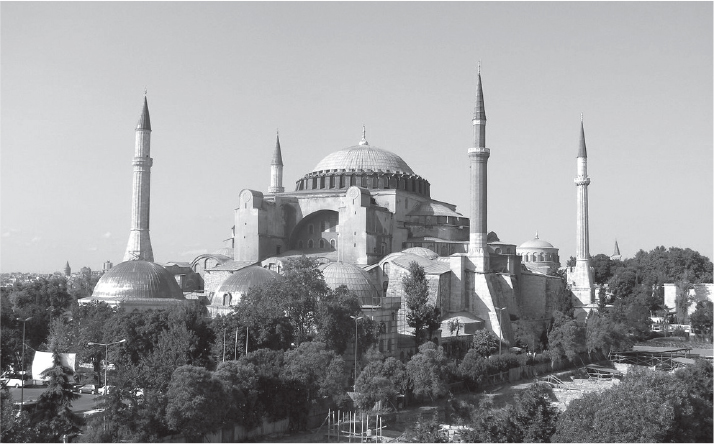
Figure 11

Figure 12
40.Who was the patron of this building?
(A)Constantine the Great
(B)Justinian
(C)Augustus of Prima Porta
(D)Suleyman the Magnificent
41.A key architectural feature first developed in this building is the
(A)muqarnas
(B)nave
(C)narthex
(D)pendentive
Question 42 refers to Figure 13.
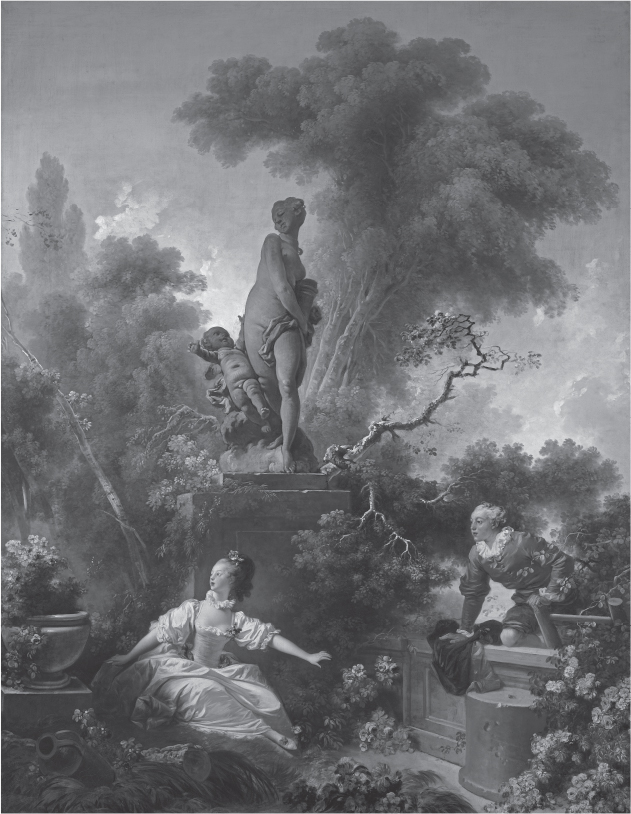
Figure 13
42.This work can be attributed to which of the following artists?
(A)Jacques-Louis David
(B)Eugène Delacroix
(C)Jean-Honoré Fragonard
(D)Vincent van Gogh

43.Colophons are often seen
(A)on Japanese screens
(B)at the base of Roman monuments
(C)on Renaissance frescoes
(D)on Chinese scrolls
44.The Golden Stool is held to be a sacred item in part because it is
(A)used as part of the throne for the kings of Ghana
(B)the symbol of the Ashanti nation
(C)used in all coming-of-age ceremonies
(D)decorated with royal symbols
45.The design of the navigation charts of the Marshall Islands is difficult to interpret because the charts
(A)are written in Polynesian script
(B)are done in abstract designs
(C)are understood only by the person who created them
(D)are easily broken and have come down to us in fragmentary condition
46.Julie Mehretu’s works have an animation and a sweeping vibrant pulse similar to the works of
(A)Andy Warhol
(B)Constantin Brancusi
(C)Vassily Kandinsky
(D)Meret Oppenheim
Question 47 refers to Figure 14.
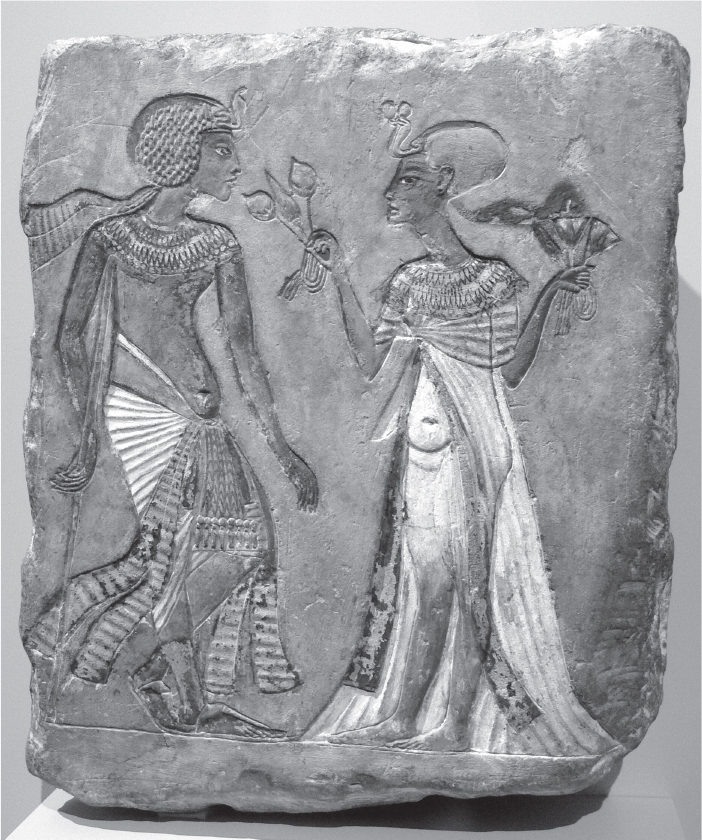
Figure 14
47.This work can be attributed to which of the following art historical periods?
(A)Amarna
(B)Babylonian
(C)Etruscan
(D)Egyptian Old Kingdom

48.We know that the Basin by Muhammad ibn al-Zain must have been a special work for the artist because
(A)it ended up in the possession of the King of France
(B)he signed the work six times
(C)he decorated it with hunting scenes
(D)it is made of pewter
49.The International Style of mid-twentieth-century architecture stressed
(A)streamlined spaces and spare decoration
(B)a revival of hand-crafted and manually worked details
(C)a new look at traditional ornamentation, casting it in a modern way
(D)cantilever construction techniques
50.Which one of the following artists expressed his ideas about art in influential essays?
(A)Ernst Kirchner
(B)Paul Cézanne
(C)Vassily Kandinsky
(D)Georges Braque
Question 51 refers to Figure 15.

Figure 15
51.The artist of this self-portrait thought of his art as
(A)an artistic as well as a political statement
(B)an extension of the Impressionist style
(C)a bridge between traditional art forms and modern modes of expression
(D)an effort to harmonize European art techniques with African influences
Questions 52–54 refer to Figures 16 and 17.
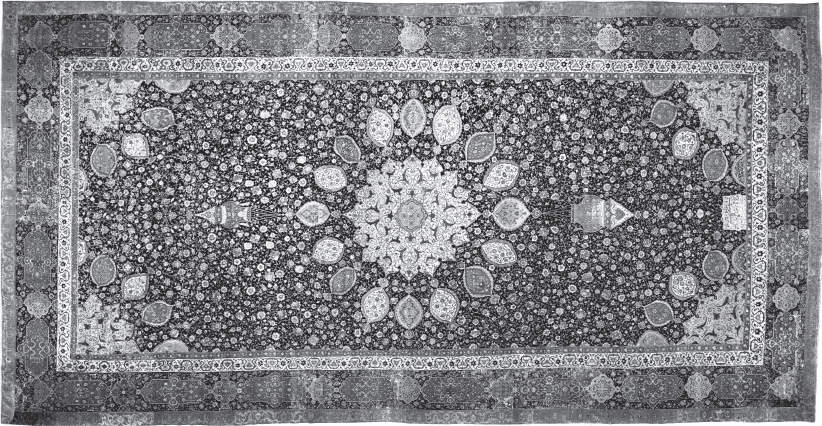
Figure 16

Figure 17
52.The work on the left was used for prayer for which faith?
(A)Buddhism
(B)Hinduism
(C)Judaism
(D)Islam
53.The work on the right is woven because it is
(A)the traditional artistic occupation of women
(B)meant to be beautiful but also have a function
(C)a commentary on the contemporary neglect of woven works of art
(D)meant to be worn
54.The artist in the work on the right appropriates images from the works of
(A)Michelangelo
(B)Gustave Courbet
(C)Leonardo da Vinci
(D)Rembrandt

55.The general Muslim and Jewish ban on religious images influenced the destruction of images in which period?
(A)Byzantine
(B)Romanesque
(C)Gothic
(D)Late Antique
56.Northern Renaissance altarpieces are different from Italian ones in that the Northern ones
(A)have predellas
(B)are cupboards with wings that close
(C)have fanciful frames
(D)are located in a church
57.The discovery of the caves at Lascaux solidified the opinion that
(A)the Trojan epics were retellings of actual events
(B)Pompeii was buried by volcanic ash
(C)Stonehenge was a unique ancient monument
(D)prehistoric cave paintings are genuine and not the work of modern forgers
58.The lost wax process, sometimes called cire perdue, is a method of sculpture seen in which of the following works?
(A)Greek marble sculpture
(B)Islamic ivories
(C)Northwest Coast Indian transformation masks
(D)Benin brasses and bronzes
59.Worshippers at the Kaaba, who are making the hajj,
(A)sacrifice animals to show that they give their most valued possessions to God
(B)bring offerings and gifts to the deity whose statue is contained within
(C)visit relics located in chapels around the east end of the shrine
(D)circumambulate the shrine seven times
Questions 60–62 refer to Figure 18.
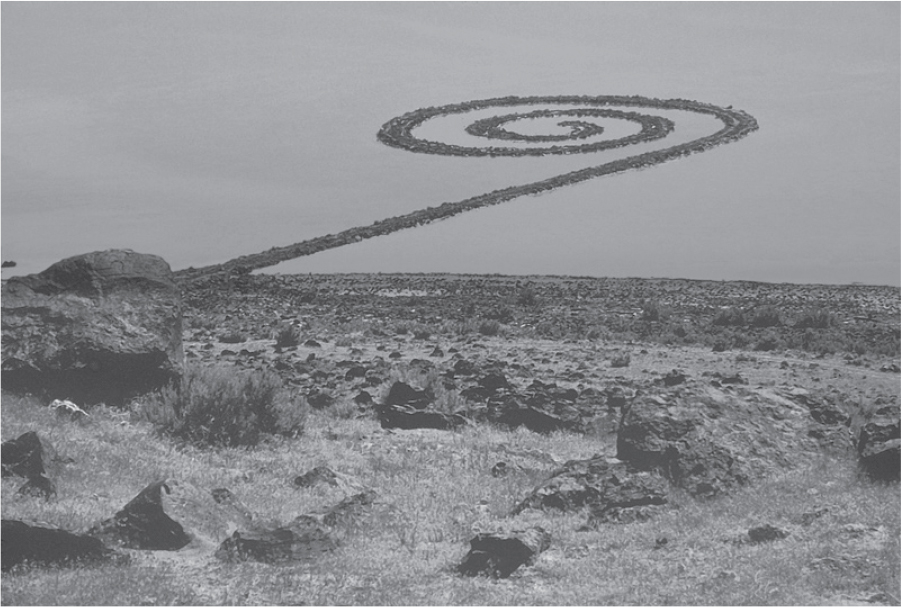
Figure 18
60.This work is in situ meaning it
(A)is made of man-made products
(B)can be seen with the use of a special device
(C)changes color depending on the time of day
(D)is in its original location
61.This work has been particularly designed
(A)to be far from civilization
(B)to align with the movements of the sun and the moon
(C)so that boats can dock alongside it
(D)to be viewed both by day and night
62.This work draws inspiration from works like
(A)the Great Stupa at Sanchi
(B)the Serpent Mound in Ohio
(C)Machu Picchu in Peru
(D)the ruins of the city of Pompeii

63.Daumier’s Nadar Raising Photography to the Height of Art indicates a tone of
(A)admiration because Daumier felt that photography could achieve a kind of greatness formerly known only to painting
(B)condemnation in that the artist feels that a photograph is a mechanical device and not worthy of being classified as an art form
(C)gentle mockery because Nadar is made to look foolish and funny in his situation
(D)indifference because Daumier felt that photography was not an art form
64.The Harlem Renaissance refers to a period that
(A)rejected any art as inspiration that was political in nature
(B)aggressively rejected modernism
(C)promoted African-American aesthetics in all the arts
(D)encouraged African-Americans to conform to white standards of art production
65.Feathers were often used in Mesoamerican royal regalia because
(A)exotic birds were plentiful and easy to catch
(B)the feathers symbolized birds and hence freedom; kings felt they symbolically flew over other people
(C)feathers made both lightweight and durable garments
(D)the rareness of certain kinds of feathers indicated the wealth of the kings
66.Etchings are different from engraving in that etchings
(A)require a metal plate as a ground
(B)use a tool to cut into a surface
(C)must be realized by passing paper over the impression
(D)must be immersed in acid to achieve an image
67.Leonardo da Vinci’s Last Supper is in a ruined condition today because
(A)Leonardo experimented with different types of paint
(B)the patrons were angry at the outcome and had the work mutilated
(C)tastes change, and the work was going to be replaced because it looked out of fashion
(D)the Nazis tried to remove it in World War II and damaged it
Questions 68 and 69 refer to Figure 19.
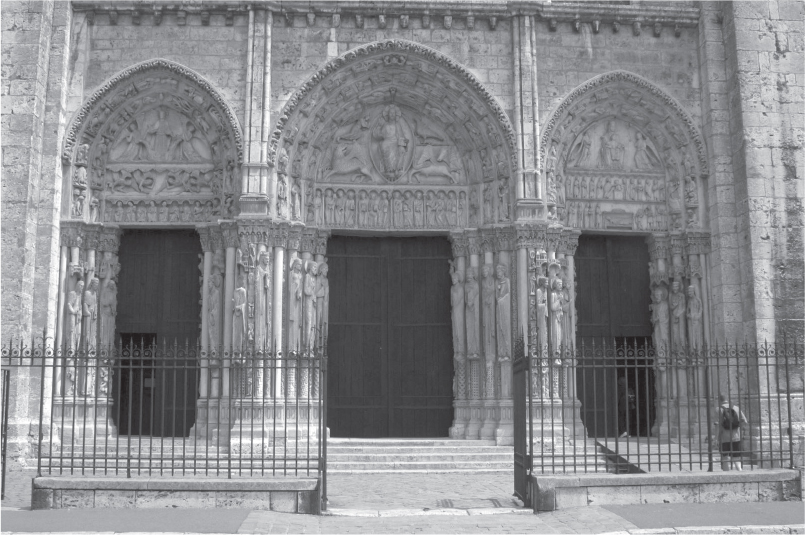
Figure 19
68.Contextually, the figures on the Great Portals of Chartres
(A)physically and morally support the church behind them
(B)act as an interpreter for those who are not Christian
(C)are in the spot where royalty must pray
(D)are symbols of the revival of the Catholic faith during the Counter-Reformation
69.This kind of grouping of sculpture and architecture can be found also at
(A)the Taj Mahal
(B)Dome of the Rock
(C)Hagia Sophia
(D)Lakshmana Temple
Question 70 refers to Figure 20.
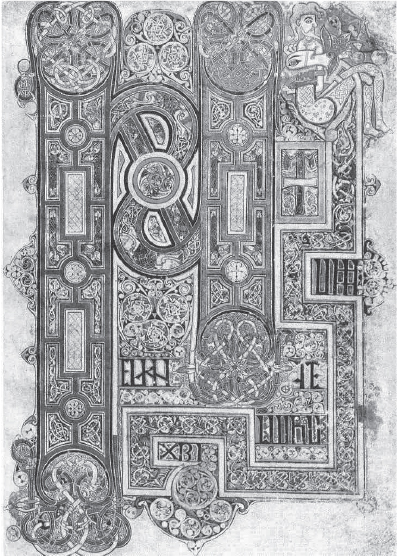
Figure 20
70.The visual evidence in this work indicates that it is
(A)a dedication page for a moralized Bible
(B)an icon for religious worship
(C)a cross-carpet page in a manuscript
(D)the opening Gospel page in a manuscript
71.Quoins are architectural features used primarily
(A)around a pediment
(B)in Asian building traditions
(C)on the edges of buildings
(D)along stringcourses and cornices
72.Etruscan architecture is largely known to us today through the
(A)writings of Vitruvius
(B)excavations at Pompeii
(C)books of Palladio
(D)descriptions made by Greek historians
73.Baroque ceiling paintings, like those by Giovanni Battista Gaulli,
(A)compartmentalize the ceiling into equal units
(B)include general scenes in the main vault to symbolize everyday life
(C)focus the attention of the viewer down the aisle to the altar
(D)symbolically open up the ceiling as if looking into the sky
74.Graywacke was favored by ancient Egyptian sculptors because
(A)the color symbolized royalty
(B)its rarity symbolized royal wealth and trade
(C)its denseness made it suitable for architectural elements
(D)its hardness symbolized eternity
75.The exterior and interior decoration of the Houses of Parliament, or Palace of Westminster, shows a cultural identification with
(A)Romanesque architecture, with its spaces designed to accommodate relics
(B)Renaissance design principles as articulated in Italy
(C)developments in cast-iron architecture, as a modern way to construct large-scale buildings
(D)the symbolism of Perpendicular Gothic and its history as an English architectural style
76.A manuscript that is a moralized Bible is one in which
(A)only excerpts from the Bible that end with morals are represented
(B)the Old Testament stories are juxtaposed to New Testament stories
(C)the Bible has added pages with modern commentaries
(D)the Bible is thoroughly footnoted and researched
77.Jan Vermeer’s paintings suggest that he had knowledge of
(A)lithography
(B)the daguerreotype
(C)the camera obscura
(D)the orrery
78.The material used to make bandolier bags relies on
(A)trade with European settlers
(B)manufactured goods available during the Industrial Revolution
(C)the reuse of older material in a new context
(D)the recycling of older bags for more modern use
79.In Claude Monet’s Saint-Lazare Station, the artist represented the
(A)effect of light and air on a given subject
(B)breakdown of reality into its composite forms
(C)rearranging of reality into different geometric shapes
(D)sharp contrast of light and dark areas
Question 80 refers to Figure 21.
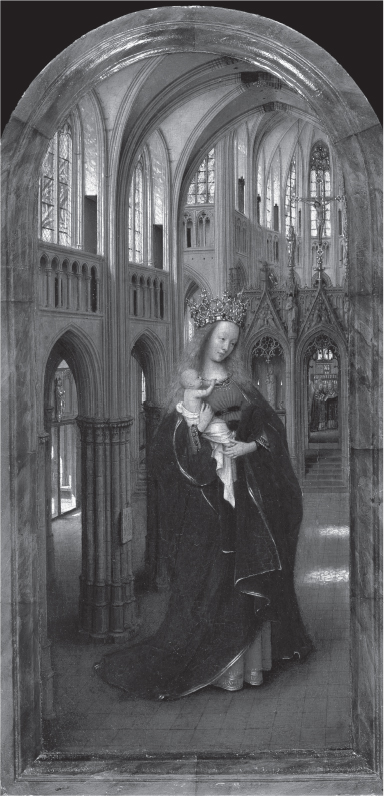
Figure 21
80.This painting can be attributed to Jan van Eyck because of the
(A)broad open brushwork
(B)meticulous detail
(C)symmetrical composition
(D)use of contrapposto
SECTION II
TIME: TWO HOURS
6 QUESTIONS
DIRECTIONS: You have two hours to answer the six questions in this section.
Questions 1 and 2 are long essay questions, and you are advised to spend one hour on both.
Questions 3 through 6 are short essay questions, and you are advised to spend 15 minutes on each.
During the actual exam, the proctor will announce when each question’s time limit has been reached, but you may proceed freely from one question to another.
Some of the questions refer to images; some do not.
Read the questions carefully. You can receive full credit only by directly answering all aspects of the question.
Question 1: 35 minutes suggested time
Books have been created not only to preserve the written word but also to illustrate important concepts that the words represent. Often books have become highly decorated works of art in their own right, as much treasured for their illustrations as for their words.
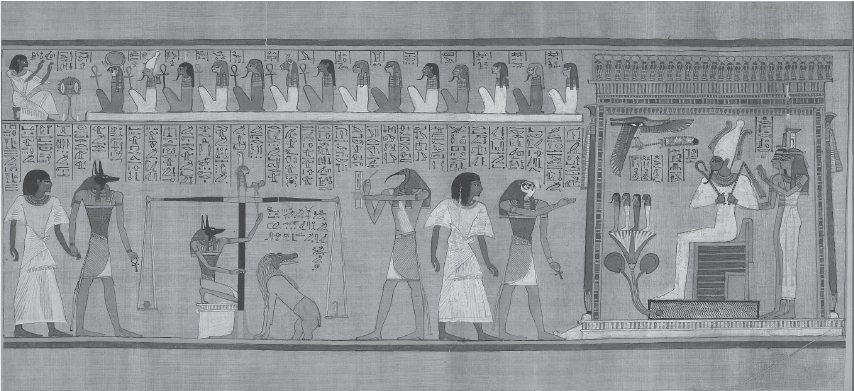
This book shows a section from the Last judgment of Hunefer from the Book of the Dead, c. 1275 B.C.E., painted papyrus scroll.
Select and identify another work of art that is a selection from a book. You may select a work from the list or any other relevant work.
For both the Last judgment of Hunefer and your selected work, describe the scene in the work.
Analyze how the illustrations add meaning to the written content of each work.
Using at least one example of visual evidence, explain how each book is an important illustration of the culture that produced it.
Explain at least one difference in how these books function.
You may either select a work from the list below or select one of your own choosing. You are not limited to the works in the official image set.
The Court of Gayumars, folio from Shah Tahmasp’s Shahnama
Frontispiece of the Codex Mendoza
Golden Haggadah (The Plagues of Egypt, Scenes of Liberation, and Preparation for Passover)
Question 2: 25 minutes suggested time
In Northern Renaissance art, artists often used symbolism to create meaning in a work of art.
Select and completely identify a work of art from the list below, or any other relevant work from the Northern Renaissance.
Explain how the artist used symbolism to create meaning in the work you have selected.
In your answer, make sure to:
■Accurately identify the work you have chosen with at least two identifiers beyond those given.
■Respond to the question with an art historically defensible thesis statement.
■Support your claim with at least two examples of visual and/or contextual evidence.
■Explain how the evidence that you have supplied supports your thesis.
■Use your evidence to corroborate or modify your thesis.
Arnolfini Portrait
Annunciation Triptych (Merode Altarpiece)
Allegory of Law and Grace
Question 3: 15 minutes suggested time

This work is Laocoön and his sons from the early first century C.E. by three artists from the Rhodes School.
Describe at least two visual characteristics of the work.
Using specific visual evidence, explain at least two techniques that the artists used to create a sense of drama in this work.
Explain how this work is part of the Hellenistic tradition of sculpture.
Question 4: 15 minutes suggested time
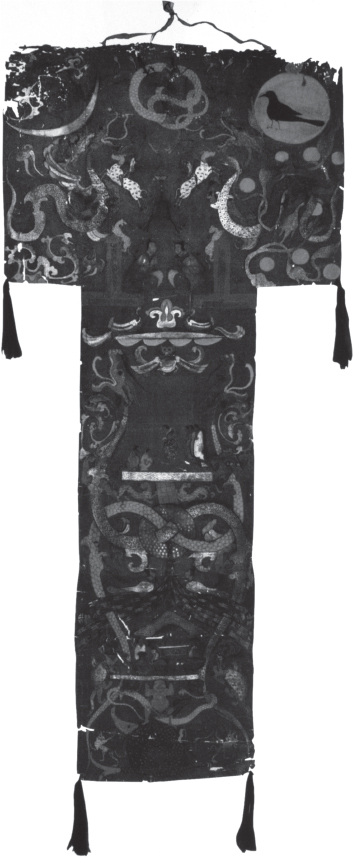
This work is the Funeral banner of Lady Dai (Xin Zhui), 180 B.C.E., painted silk.
Where was this work found?
Using specific visual evidence, discuss how the original context influenced the choice of materials and imagery.
Using at least two examples of contextual evidence, discuss how this work represents aspects of Chinese philosophy.
Question 5: 15 minutes suggested time
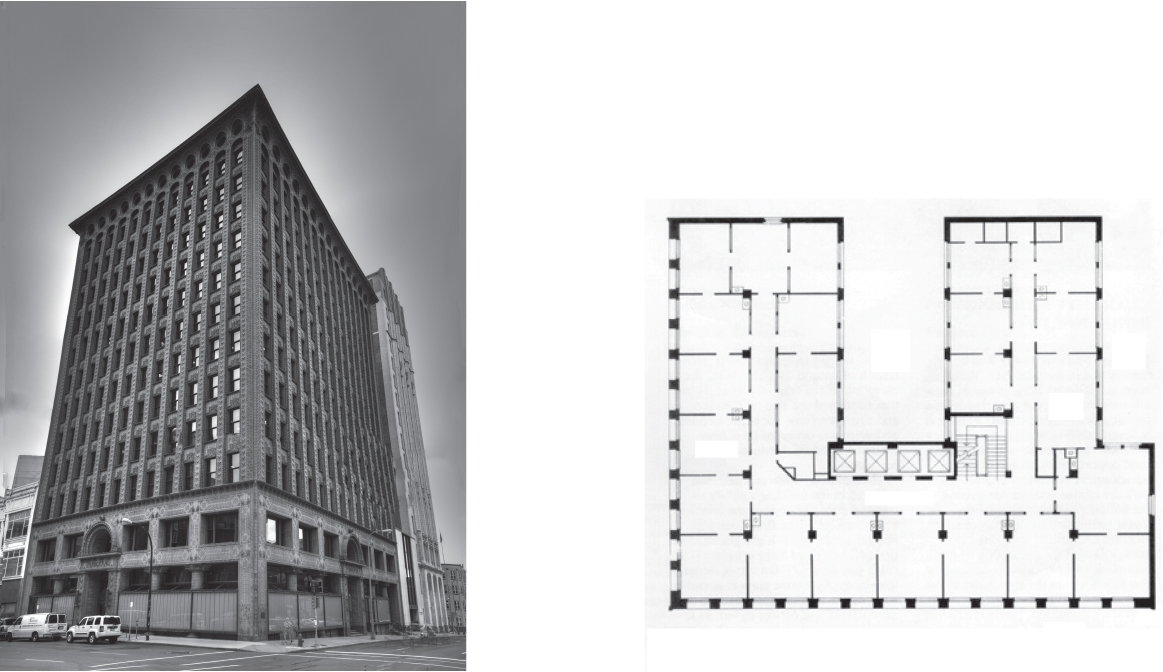
Attribute this building to the architect who designed it.
Discuss at least two specific details that justify your attribution by comparing this work to another work by the same architect in the required course content.
Discuss at least two developments in the history of architecture that this architect used in the design of this building. Use both the photograph and the plan in your discussion.
Question 6: 15 minutes suggested time
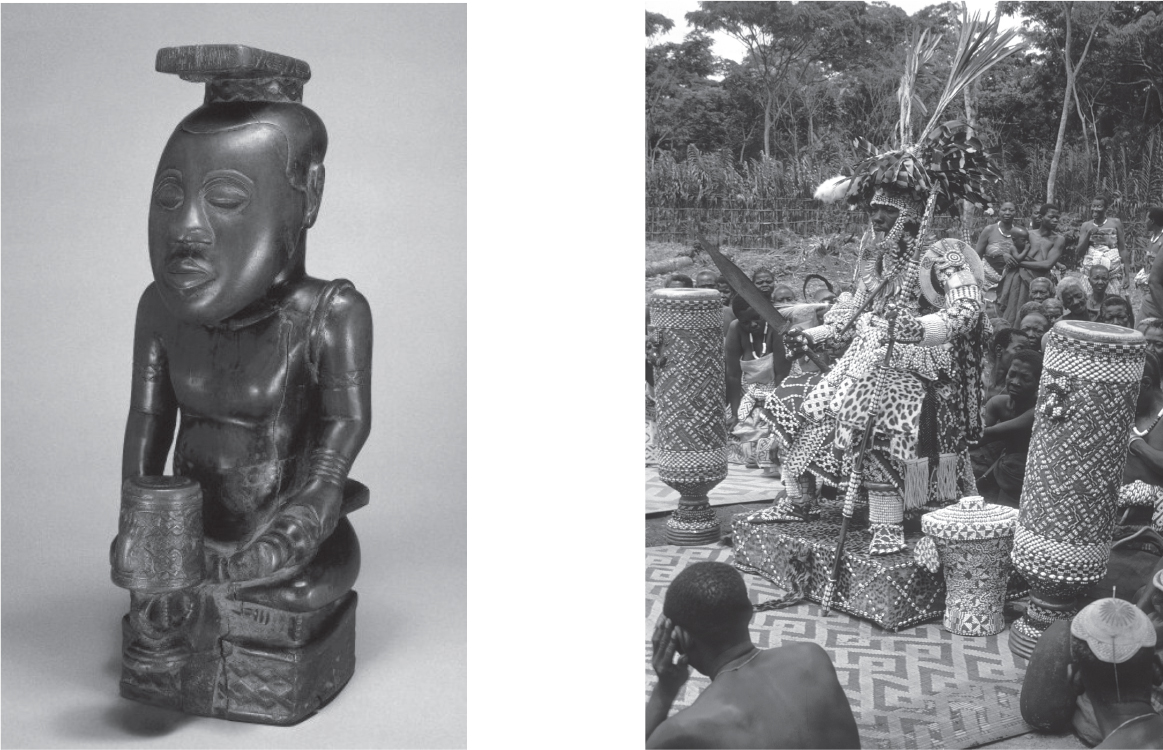
On the left is a ndop, a portrait figure of King Mishe miShyaang maMbul. On the right is a contextual image of Kuba Nyim (ruler) Kot a Mbweeky III in state dress with royal drum in Mushenge, Congo. The sculpture and the photograph represent a continuing tradition of the Kuba people which extends to today.
Explain the purpose of ndop figures.
Discuss at least two specific visual elements in this work that illustrate its purpose.
Explain at least two reasons how these elements continue to represent the Kuba king today, as seen in the contextual photograph.